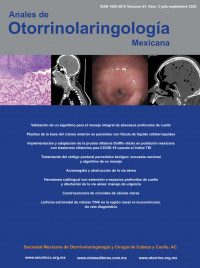Implementation and adaptation of the Sniffin sticks olfactory test in a Mexican population with olfactory disorders caused by COVID-19, using the TDI score.
An Orl Mex. 2022; 67 (3): 201-206. https://doi.org/10.24245/aorl.v67i3.7915
Daniel Dibildox,1 Paula Loyola-Nieto,2 Eduardo Brenner-Muslera,2 Daniel Guerra-Arellano,2 Fernando Loyola-Nieto,2 Armando Maldonado-Cobá2
1 Hospital Médica Sur, Ciudad de México.
2 Facultad de Ciencias de la Salud, Universidad Panamericana, Ciudad de México.
Resumen
OBJETIVO: Realizar una adaptación y validación de los Sniffin sticks® y el índice TDI para pacientes mexicanos con alteraciones olfatorias secundarias a la infección por SARS-CoV-2.
MATERIALES Y MÉTODOS: Estudio longitudinal, prospectivo, prolectivo, observacional y descriptivo, realizado de noviembre de 2021 a abril de 2022, en el que se incluyeron pacientes de 18 a 65 años, que persistieron con anosmia, hiposmia u otra alteración de la olfacción posterior al diagnóstico de COVID-19; se utilizaron los Sniffin sticks® y el índice TDI con modificaciones culturales para valorar la función olfatoria. Las mediciones se dividieron en tres subsecciones.
RESULTADOS: Se incluyeron 27 pacientes. El promedio del tiempo entre el diagnóstico de COVID-19 y la evaluación olfativa con Sniffin sticks® fue de 9.4 meses, con límites de 2.9 y 18.5 meses. La evaluación demostró anosmia en al menos un rubro en prácticamente todos los participantes del estudio. El promedio del umbral fue de 6.30 (IC95%, 5.757-6.843) de 8 aciertos, el de la discriminación de 8.15 (IC95%, 7.46-8.84) de 12 aciertos y la identificación de 6.37 (IC95%, 5.506-7.234) de 12 aciertos. Por su parte, la evaluación global del TDI fue de 0.67 (IC95%, 0.63-0.71).
CONCLUSIONES: La importancia de la adaptación radica no solo en otorgar mayor credibilidad a estas herramientas y cuantificar la capacidad olfatoria de manera objetiva, sino también en ofrecer la posibilidad de replicar esta adaptación en poblaciones con alteraciones olfatorias de causa distinta a la viral.
PALABRAS CLAVE: COVID-19, anosmia, hiposmia, evaluación olfatoria, SARS-CoV-2.
Abstract
OBJECTIVE: To develop an adaptation of the Sniffin sticks® and the TDI score that is suitable for Mexican patients with olfactory alterations secondary to SARS-CoV-2 infection.
MATERIALS AND METHODS: A longitudinal, prospective, prolective, descriptive and observational study done from November 2021 to April 2022 with patients aged 18 to 65 years, who persisted with anosmia, hyposmia or other olfactory impairment following diagnosis of COVID-19. The Sniffin sticks® and the TDI score with cultural modifications were used to assess olfactory function. Measurements were divided into three subsections.
RESULTS: There were included 27 patients. The average time between COVID-19 diagnosis and olfaction evaluation with Sniffin sticks® was of 9.4 months (2.9-18-5 months). The assessment demonstrated anosmia in at least one item in virtually all study participants. The mean threshold was 6.30 (95% CI, 5.757-6.843) out of eight hits, discrimination was 8.15 (95% CI, 7.46-8.84) out of 12 hits, and identification was 6.37 (95% CI, 5.506-7.234) out of 12 hits. The overall evaluation of the TDI was 0.67 (95% CI, 0.63-0.71).
CONCLUSIONS: The importance of this adaptation lies not only in giving greater credibility to these tools and in evaluating olfactory capacity in an objective manner, but also in offering the possibility of replicating this adaptation in populations with olfactory alterations of an etiology other than viral.
KEYWORDS: COVID-19, anosmia, hyposmia, olfactory evaluation, SARS-CoV-2.
Recibido: 8 de julio 2022
Aceptado: 21 de agosto 2022
Este artículo debe citarse como: Dibildox D, Loyola-Nieto P, Brenner-Muslera E, Guerra-Arellano D, Loyola-Nieto F, Maldonado-Cobá A. Implementación y adaptación de la prueba olfatoria Sniffin sticks en población mexicana con trastornos olfatorios pos-COVID-19 usando el índice TDI. An Orl Mex 2022; 67 (3): 201-206.


